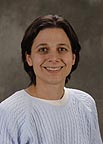February 19, 2008
Physics researcher wins CAREER award from NSF
CARBONDALE, Ill. — An assistant professor of physics at Southern Illinois University Carbondale has won a coveted grant from the federal government aimed at establishing promising junior researchers by providing long-term funding for their work.
María de las Mercedes Calbi recently received a CAREER award from the National Science Foundation to support her research project, titled "Kinetics of Adsorption in Nanoporous Structures." The $400,000 grant will last through 2013.
Calbi is developing theoretical models and methods aimed at understanding how molecules and atoms gain access and bind to carbon nanotube bundles, and how fast they can do it. The work, much of which Calbi will do with computer simulations, has great potential in areas such as gas separation, purification and storage.
CAREER grants support early career research and teaching activities and are highly competitive. Calbi said winning the award is thrilling.
"It's a great opportunity for young faculty as it can fund your research for five years," said Calbi, who joined the Department of Physics in the College of Science at SIUC in 2003. "I've had great support from our faculty and the head of the department here, which is very important because the award is so competitive that it is very easy to get discouraged while applying.
"This shows we can compete with any other university," she said. "It shows you can do it at SIUC."
Although atom and molecule adsorption has been used for some time in areas such as gas separation, Calbi's work moves the concept forward by focusing on how carbon nanotube bundles behave in this arena. The structures are extremely tiny — a nanometer is one billionth of a meter — collections of long, hollow tubes that form spontaneously under given conditions.
Because of their shapes and porous nature, the structures provide several different types of surfaces as bonding points for atoms and molecules, allowing Calbi and her team of students to efficiently study the adsorption process under different conditions. The atoms and molecules can attach themselves inside a nanotube or along the valley-like areas that run along the outside of the tubes, for instance. The structures also contain interstitial pores between the tubes, which provide additional potential bonding points.
Calbi also wants to know how to ensure the strongest possible bond between the gas and structures. She also wants to study how quickly certain atoms and molecules can gain access to and bond with a surface, an area known as adsorption kinetics.
She also will look at the relationship between the size of pore in relation to the size of atom or molecule and how it affects bonding strength. The closer in size generally means the stronger the bond, but this also makes access more restrictive. Calbi will examine how this trait plays into the overall question of adsorption.
Calbi also will look for efficient combinations that balance the time it takes for adsorption against the energy required to do so using different atoms and molecules under various conditions.
While she will focus on nanotube bundles to extract this knowledge, Calbi's goal is to obtain the basic principles that could be used to understand such processes in other nanomaterials, or even to design nanostructures with specific applications.
Because of its nano-scale nature, Calbi's work will delve into the world of quantum mechanics, which operates under an entirely different set of laws than classical physics.
"Much of it is really unknown," Calbi said. "When you have diffusion of molecules in restricted spaces, such as inside a nanotube, the molecules can behave in a very different way."
Although she will do most of the work with theoretical models and computer simulations, Calbi also will work closely with Aldo Migone, professor and chair of the physics department, who will test various concepts in his laboratory. Migone's work will confirm or disprove the various theories and models Calbi's team advances.
Nanotube structures, such as those Calbi works with, are promising materials for separation and membrane applications. When fully understood, one possible use might involve efficient hydrogen storage methods, which could open a variety of environmentally sound technologies. Other possible applications include air purification systems and environmental remediation.
Another important aspect to the grant involves student outreach and education. Calbi will hire three graduate students and one undergraduate student to work on the project, which will provide an important research opportunity for them. She also plans a new physics course on surface science at nano scale, which will emphasize using computers to model processes that occur at such a small scale.
"It will teach students how to use a computer as a tool for doing physics research," she said.
Calbi also will continue working with the annual "Expanding Your Horizons" mathematics and science event at SIUC, which is aimed at encouraging girls in seventh-ninth grades to consider careers in those fields.
"While I lead my workshop, the girls will also get to know the work I'm doing here as a scientist and I really want to convey the message, 'see, you can do this too,'" Calbi said.
Calbi earned her doctorate degree in physics in 2000 at the University of Buenos Aires, Argentina. She then worked as a post-doctoral fellow in the physics department at The Pennsylvania State University from 2000 to 2003 before being hired at SIUC as assistant professor of physics.

